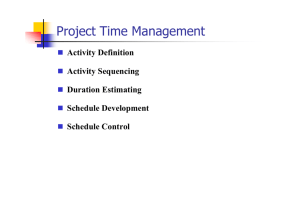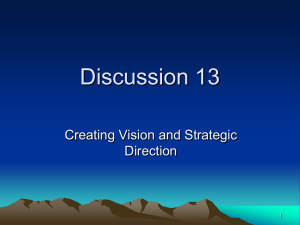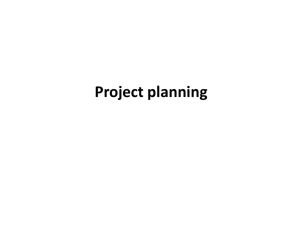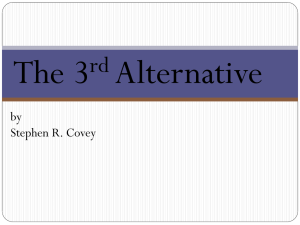M14. Project Management
advertisement
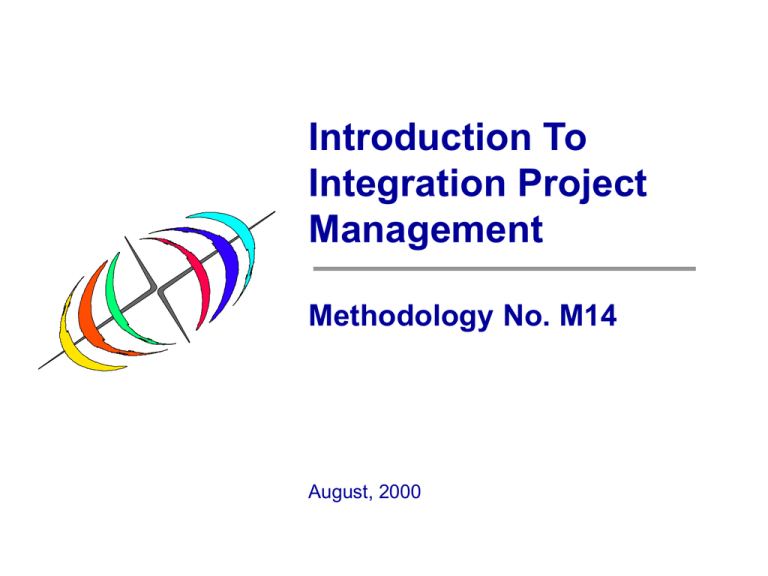
Introduction To Integration Project Management Methodology No. M14 August, 2000 Contents • Purpose and Objectives • Critical Success Factors & Pitfalls • Planning & Monitoring Formats • • Tasks, Work Breakdown Structure & Resource Assignment Role of the Integration Management Office (IMO) 2 Purpose & Objectives • • • • • Explore fundamental tools and techniques Illustrate principles of project management Demonstrate the value of using project planning tools and techniques Provide simple guidelines to facilitate the use of project planning Illustrate the reasons to invest the time required to do effective planning 3 Effective Project Planning: Critical Success Factors • • • • • • • • • Start the planning process early (prior to closing if possible) Link the business strategy to tactical planning Describe the overall integration plan (for various constituents across both businesses) Manage planning and execution rigorously Document the impact to the business Communicate frequently, clearly and uniformly Involve and mobilize employees Plan-Do-Review Address efforts proactively and avoid firefighting 4 Pitfalls: When Companies Fail to Plan Effectively • • • • Employee uncertainty and frustration can negatively impact customers and stakeholders (value destruction) Organizational turmoil may increase unwanted employee turnover Managers spend too much time on minutiae, firefighting or employee concerns instead of the key activities The integration time line may become understated, while expected benefits become delayed or unrealized 5 Integration Program Management: Key Planning/Monitoring Formats MONITORING Flash Reports PLANNING Status Reports Activity Work Plans Planning Matrix Benefits Tracking Team Charters Commun. Needs Log Functional Synergy Worksheets Issues Log 6 Primary Uses For Each Of The Planning/Monitoring Formats Planning Matrix Provides a description of the end state for each functional/process area, and acts as a roadmap for the business integration effort. Team Charters Provides context for the teams reason for being. Identifies the high level what, why, when and how of each integration team. Activity Workplans Provides the work breakdown, dependencies, deliverable and timing associated with each team effort. The essence of each team plan would be rolled up into an overall integration master plan. Functional Synergy Worksheets Provides a standard format for documenting estimates of revenue enhancing, cost reduction or cash flow enhancing improvements anticipated from integration team activities. Status Report Provides a vehicle to monitor the extent to which program activities have been completed. Flash Report Provides a less formal format for reporting progress in a bullet format. Captures thoughts for a discrete period of time on key accomplishments, team “temperature”, issues and concerns, and next steps. Benefits Tracking Provides a format to track actual benefits achieved versus estimates Issue Log Provides a mechanism to identify progress limiting issues and track their resolution Communications Needs Log Provides a vehicle to identify topics that need to be communicated to different constituencies. This is a major input to the program office in their effort to disseminate program information. 7 Planning/Monitoring Formats: Integration Planning Matrix Purpose: • Provides a format to describe the intended end state for each functional/process area, and acts as a roadmap for the business integration effort Integration Area (Department, Function, Process) By department, function or process End State Concept Of Business (Operations, Organization, IS) Opportunity (H,M,L) TThheeHHooww Business Risk (H,M,L) at Whhat TThheeW Integration Complexity (H,M,L) • Provides the first comprehensive view of an integrated end state and anticipated benefits TTh heeW Whhy y Total Budgeted Headcount Target Benefits Target Integration Date Key Integration Steps Issues, Dependencies, Gating Factors How the business will operate when integrated (e.g., consolidated, integrated, centralized/decentralized, etc.) Preliminary project prioritization; Resource/ skills assessment; Risk management Quantification of opportunities; Reality check of consolidation/ integration plans What phases or interim steps are required to get to the end state What activities must other integration areas (units) perform (complete) before this integration area can begin/complete particular tasks. What external factors may impact progress (e.g., regulatory gating issues) 8 Planning/Monitoring Formats: Work Team Charters Charter Outline: Key Activities Process Logic Schedule of Work Benefits End State Vision / Description of Objectives Milestones R & R’s Sponsor Mission Objectives Work Team Manager Critical Issues Topics of Focus Measures Skills/Resources Required Critical Success Factors Deliverables Budgets Dependencies & Critical Success Factors Major Activities / Milestones Business Benefits / Measures Results Overall Timing 9 Planning/Monitoring Formats: Work Team Charters WORK TEAM CHARTER TEAM/FOCUS AREA: LEADER: END STATE VISION / DESCRIPTION OF OBJECTIVES: Purpose: • Provides context for the teams reason for being • Identifies the WHY, WHAT, WHO and WHEN for team activity at a very high level. TOPICS OF FOCUS: SKILLS/RESOURCES REQUIRED: DEPENDENCIES & CFSs: MAJOR ACTIVITIES & MILESTONES:BUSINESS BENEFITS: BUSINESS BENEFITS / KEY MEASURES: OVERALL TIMING: 10 Planning/Monitoring Formats: Activity Work Plans ACTIVITY WORK PLAN TEAM/SUB-TEAM: TEAM LEADER: Act. No. Work Breakdown Structure - Activity/Task Description Responsible Person(s) Start Date End Date Dependencies Purpose: • Provides the work breakdown and timing for the integration program • Provides timing, dependencies and primary responsibility for each activity 11 Planning/Monitoring Formats: Functional Synergy Worksheets Purpose: Provides a standard format for documenting estimates of revenue enhancing, cost reduction or cash flow enhancing improvements anticipated from integration team activities Functional Synergy Worksheet Funtion ( ___ Revenue Enhancement ___ Cost Reduction ___ Cost Avoidance Year 1 ) - Detail ___ Cash Flow/Utilization Year 2 Year 3 Year 4 Year 5 ) $ $ $ $ $ Synergy $ $ $ $ $ Assimilation Costs $ $ $ $ $ Recurring Cost of Benefit-Related Activities $ $ $ $ $ Title/Subject Net Synergy - ( As-Is To-Be Action Steps and Timing: Risks: Reporting (How to Measure): 12 Planning/Monitoring Formats: Functional Synergy Worksheets Functional Synergy Worksheet ( Net Synergies / Impact Type* Year 1 Year 2 Function Year 3 ) - Summary Year 4 Year 5 1. $ $ $ $ $ 2. $ $ $ $ $ 3. $ $ $ $ $ $ $ $ $ $ 4. 5. 6. 7. 8. 9. 10. 11. 12. 13. 14. Total Net Synergies Type: (RE) Revenue Enhancement; (CR) Cost Reduction; (CA) Cost Avoidance; (CFU) Cash Flow/Utilization 13 Planning/Monitoring Formats: Functional Synergy Worksheets Functional Synergy Worksheet ( ( Function Function ) - Overview ) - Summary Year 5 Year 4 Year 3 Year 2 Year 1 Consolidated Synergies Synergy Benefits $ $ $ $ $ Assimilation Costs $ $ $ $ $ Costs of Benefit-Related Activities $ $ $ $ $ Net Synergy $ $ $ $ $ 14 Planning/Monitoring Formats: Status Reports TEAM STATUS REPORT TEAM/SUB-TEAM: STATUS DATE: TEAM LEADER: Act. No. Work Breakdown Structure - Activity/Task Description Responsible Person(s) Start Date End Date Estimated % Complete Comments Purpose: • Provides a periodic update of the extent to which work plan activities are complete • Provides clarifying commentary regarding activity status as required 15 Planning/Monitoring Formats: Flash Reports WORK TEAM FLASH REPORT TEAM: STATUS DATE: KEY ACCOMPLISHMENTS: Purpose: • Provides a high level bullet-point update of team events and progress for a particular timeframe • Provides a vehicle to surface progresslimiting issues TEAM “TEMPERATURE”: ISSUES & CONCERNS: NEXT STEPS: 16 Planning/Monitoring Formats: Benefits Tracking Log BENEFITS LOG Benefits Realized Cash Flow Cost Reduct Cost Avoid Oppty. No. Rev. Growth Type Description of Benefit Team/Resp. Value ($000) Implement Due Date Q1 ($000) Q2 ($000) Q3 ($000) Q4 ($000) Q1 ($000) Q2 ($000) Purpose: To provide a format to track benefits expected, responsible personnel, and timeline. Specific responsibility and timeframes should be assigned. 17 Planning/Monitoring Formats: Issue Log ISSUE LOG Issue # Issue Description Submitted By (Person/Team) Assigned To Date Opened Date Closed Resolution Purpose: To provide a format to track issues that are outside the control of a single team, and that will inhibit progress unless resolved 18 Planning/Monitoring Formats: Communications Needs Log COMMUNICATIONS NEEDS LOG Item # Topic/Message Audience Date Requested Draft Responsibility Disposition Purpose: • Provide a vehicle to identify topics that need to be communicated to either internal or external constituencies • Provide a major input to the program office in their effort to disseminate program information • Provide a major input to the program office in their effort to disseminate program information 19 Project Planning Stages: Overview Work Breakdown Structure Defining Project Dimensions • WBS structure tree • Identifying major topics of focus Elements of Work What Really Needs to be Done? Definition of Dependencies What Needs to be in Place First? Getting Who You Need • Identifying key milestones • Defining phases/tasks/activities • Understanding predecessor relationships • Sequencing & preliminary schedules Assigning Resources • Skills Inventory • Responsibility Matrix • Scheduled refinement 20 Work Breakdown Structure (WBS) Work Breakdown Structure Objectives: • To establish a common method to divide complex, multifaceted programs into a consistent set of dimensions • To enable viewing a project plan in a hierarchical (taxonomic) order • To provide a structure to break larger efforts (e.g., phases, deliverables) into more discrete building elements (i.e. tasks, activities, action steps) 22 Work Breakdown Structure Approach: • List the dimensions in which people will be doing work By Team, By Geographic Area, By Topic, By Deliverable, By Phase, By Activity, etc. • Decide by which dimensions you will potentially want to “slice” (view) the ultimate work plan (e.g., all work happening in Asia) • Rationalize and standardize on a common set of planning dimensions • Organize these dimensions into a standard hierarchy • Orient all team leaders to the standard work breakdown hierarchy to which all project plans will conform 23 Work Breakdown Structure Tree Chart Team Sub-Team Geography Topic Of Focus Etc. Note: Work Breakdown Structures set the stage for resource planning, roles and responsibility mapping and identifying interdependencies to other integration deliverables 1. 1.1 1.2.1 1.2.4.1 1.2 1.2.2 1.2.4.2 1.2.3 1.2.4.3 1.2.4 1.2.4.4 1.2.4.5 1.2.4.6 The lowest levels of the hierarchy represent the actual work. . . Phases, Activities and Tasks 24 Work Breakdown Structure Example 1. Strategic/ Operational Direction Project Management 1.1 Team/SubTeam 1.1.1 Geographic Dimension Customer Commitment Finance & Administration Human Resources EMEA Topics of Focus 1.1.1.1.1.1 Asia/Pacific Communications Transition/ Shared Services Latin America Canada Country Specific Employee Benefits Terms & Conditions of Employment Compensation “As-Is” Assessment Employee Evaluation/ Selection Proc. Policies & Procedures Payroll Administration Stabilizing / Parallel Operations Activities & Tasks Information Technology Fleet Management Training Corporate/ Global Labor Relations 1.1.1.1.1 People & Properties Manufacturing Facilities Retention Process 1.1.1.1 Corporate Driven Processes “End State” / Requirements Definition Outplacement HR Information Systems Recruitment/ Staffing Job Classificatn / Career Path Etc. Consolidating / Integrating / Transforming Development Implementation 25 Example: Work Plan Using A PreDefined Work Breakdown Structure Activity# 1. 1.1 1.1.1 Activities/Tasks People & Properties Facilities Global/Corporate Base level Real Estate Organization Engage Real Estate Management Team (REMT) Prepare an agenda of needs for the REMT meeting Review/adjust REMT approach Set up structure required to manage Int'l R.E. Process Standarize facilities approach (Process Plan) Set up pyramid structure required for (5) R.E. Project Mgrs Assign the needs for facilities in each country to (x) brokers Obtain the names of the country managers Train the permanent International Real Estate associates Train the International Real Estate Project Managers Train the Delphi Country Managers 1.1.1.1.1 Note the use of left to right indentation to accentuate the WBS hierarchy 1.1.1.1.1.1 1.1.1.1.1.2 1.1.1.1.1.3 1.1.1.1.1.4 1.1.1.1.1.5 1.1.1.1.1.6 1.1.1.1.1.7 1.1.1.1.1.8 1.1.1.1.1.9 1.1.1.1.1.10 1.1.1.1.1.11 Team Planning Needs Develop a list of countries that require a facility Establish the priority for facilities Develop a master working schedule and dates Develop a master status report 1.1.1.1.2 Sub-Team 1.1.1.1.2.1 1.1.1.1.2.2 1.1.1.1.2.3 Region 1.1.1.1.2.4 1.1.2 1.1.2.1 Country EMEA Austria Develop preliminary space plan Perform project verification Select site Negotiate lease/rent arrangements Specify interior requirements Design interior of facitlity/Develop construction plans Approve design Approve R.A. Execute lease Order furniture and equipment Construct facility ("Build Out") Relocate to new facility Close out process 1.1.2.1.1 1.1.2.1.2 1.1.2.1.3 Topic of Focus 1.1.2.1.4 1.1.2.1.5 1.1.2.1.6 Activities 1.1.2.1.7 1.1.2.1.8 1.1.2.1.9 1.1.2.1.10 1.1.2.1.11 1.1.2.1.12 1.1.2.1.13 1.1.2.2 Belgium Etc. 26 Elements of Work Elements of Work Milestones Interim goals that are used to track the progress of the project. These events typically represent the beginning or end of a phase. Phases A phase represents major stages of The project. It consists of a group of related tasks. Breaking the project Into phases allows you to focus on One aspect of the project at a time. Tasks/Activities A task represents actual work that will be done on your project. Completion of task moves the project forward measurably. Examples Shared Service Center Operational As-Is Assessment Requirements Definition Development Implementation Define Organization Structure Identify Open Positions Recruit for Open Positions Train Staff 28 Remember: The Bottom-Level Tasks Should. . . • Have a tangible or measurable output/ outcome • Be unambiguous • Work within the same task should occur within a sequential or parallel time frame or order • Should only include related work elements • Have identifiable and readily available inputs • Be a finite, manageable unit of work • Require a limited number of resources - most steps should have a single team member responsible • Fit into the natural order of work progression 29 Definition of Dependencies Types Of Dependencies Dependency Type Gantt Chart Depiction Finish-to-Start A task starts after its predecessor finishes Start-to-Start A task starts when its predecessor starts Finish-to-Finish A task finishes when its predecessor finishes Start-to-Finish A task finishes after its predecessor starts 31 Determining Task Dependencies: An Example Of Building A House Rough In Plumbing Grade Land Dig/Pour Foundation Frame House Task Node: Implies Work Effort Exerted and Deliverable Completed Dependency Arrow: Shows Task Relationships from Predecessor to Successor Finish Walls Paint Interior Rough In Electrical Move In Install Roof Paint Exterior Install Windows & Siding 32 Guidelines for Validating Task Interdependence For each task, ask: • A What must be done before? A • What can be done at the same time? • What will be done after? A 33 Assigning Resources Roles and Responsibility Mapping: Objectives: To introduce a structured approach to participative management and informed decision making. To establish clear work roles in a framework that facilitates work assignment, management, measuring and alignment. To offer a logical process that lays out work deliverables and tasks to be performed, then assigns accountability, responsibility, contribution expectations and identifies who needs to be informed that these activities are going on. ARCI is an iterative and empowering process that resolves ambiguities, omissions, redundancies and confusion surrounding work assignment and performance. Roles and Responsibility Mapping (ARCI) Key Definitions Accountability: Makes the Decision The person ultimately accountable. Includes strategic authority, yes-no, veto and assignment powers, and final approval. A R Responsibility: Perform the work C Contribute: I The person(s) assigned the job by the “A”. Includes tactical responsibility for doing the work and completing the tasks. Communicate the work (2-way) The person(s) who provide special support or should be consulted in making decisions or doing work. Inform: Socialize the Work (1-way) The person(s) needing to be informed at key decision points during the work. The work’s providers, customers and beneficiaries. Accountable Sample ARCI Matrix. Inform Responsible Inform Contribute By Individual A R C I Accountable Responsible Contribute Inform 1. Assess requirements 2. Design business system A,R 3. Identify potential package options A.R 4. Purchase package 5. Modify purchased package 6. Modify in-house procedures 7. etc. 8. etc. 9. etc. A R A R R A,R C R A.R A.R C A R C A,R A.R 10. etc. R 11. etc. R R 12. etc. 37 Integration Management Office Divisional Executive Group IMO Protocols Functional Integration Teams Engineering: Purchasing: PC&L: IS&S: HR: ERP Quick Hits Change Management Training and Skills Transfer Implementation Management Project Planning and Scheduling Measures, Tracking and Reporting Knowledge Capture and Management Communications and Culture-Building Finance: Mfg/Ops Facilities Cross-Company Resources The Integration Management Office will be the “nerve center” for the integration program 38 Role & Responsibilities – Integration Management Office • Provide the physical and virtual environment to support: • Program Management • Communications • Knowledge Sharing • Provide the physical and psychological space for the Integration Manager and team members to conduct meetings, facilitate communications, maintain files and documents, resolve issues and prominently display progress • Provide uniform global access of integration information to teams • Provide visibility regarding program performance • Provide the resources to orient/train integration participants and oversee consistent execution • Ensure that roles & responsibilities are clearly articulated • Provide a formal mechanism/cycle for program review • Provide a “hot line” to the organization regarding integration activities 39 The Physical IMO Environment Should Prominently Display Plans and Progress Example of “War Room” wall in the IMO Project Approach Project Schedule X X X X X X Project Benefits XXXXXXXXXXX Early Win Scoreboard Project ARCI Weekly Flash Reports Work Team Charter Goal Goal Goal 40

